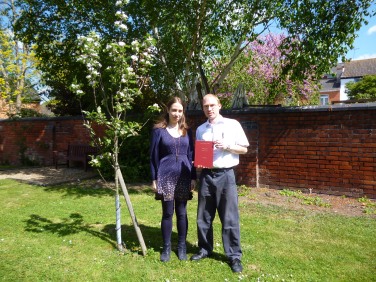There are countless hidden gems in Gloucestershire Archives’ collections. These range from beautifully illuminated medieval manuscripts to nuggets of priceless information and funny facts, often concealed in ordinary-looking documents. These treasures are usually uncovered in the Archives’ research room, either by visitors using our collections or by Archives staff that handle them as part of our access arrangements.
It seems a shame to keep these special finds a secret so we thought we’d set up a new blog series to share them with you, beginning with a post we’ve written ourselves. Here it is:
Have you ever felt like eating Hens’ Turds? We have, but we were put off by their unappetising appearance. Mind you, it turns out they aren’t meant to be eaten raw, as they taste as bad as they look in their uncooked state – quite acidic with astringent qualities. But they do become edible with processing…
Before we go any further, we should explain that Hens’ Turds are actually a variety of apple: a cider apple native to Gloucestershire and listed as critically rare in 2000. We’re guessing this is still the case – so you’d be more likely to find half a hen’s tooth in a field of haystacks.
We know about this unusual species thanks to a book in our collections: one that a recent visitor wanted to look at. It’s called ‘Native Apples of Gloucestershire’ by Charles Martell (ref. B544/56497) and contains a detailed inventory of all known indigenous varieties of Gloucestershire apples. Before checking it out, we thought we’d test our apple knowledge by listing the names of as many apples as we could. And we came up with a total of ten (listed as ‘the magnificent ten’ below). None of them were from Gloucestershire, though. Maybe you can do better?
Well, how did you get on? More than ten types of apple is good. More than twenty is even better. And a whopping fifty would be seriously impressive. But the prize fund is reserved for anyone with a list of over 190 varieties, because that’s the number listed in the book as native to Gloucestershire alone.
Martell set out to create his definitive account because many varieties of local apples were gradually disappearing. And his findings are useful for conservation and reference purposes. So if you want to identify an apple as being of Gloucestershire origin, or you’ve stumbled across a new example of Belchers Pearmain, this is a marvellous book to consult. Browsing its contents, we discovered: the last record of a Captain Kernel tree was before 1960 in Tibberton; there aren’t any Dainty Maids left in Cam; Rissington Redstreak has also been lost; and, sadly, there are only two Hard Knock trees remaining in Oxenton and only one Old Tankard in Westbury-on-Severn.
This trend reflects the ever decreasing acreage of traditional orchards in the County – currently around 3,000 acres, considerably less than the 15,000 estimated in the mid-1800s. Fortunately, Martell is propagating some of the lost and rare varieties of local apples, and these now form the National Collection of Gloucestershire Apples.
Interestingly, according to local legend, there’s also been an apple-linked manslaughter. Apparently, the Kill Boy apple came by its name after an Oldbury-on-Severn man became so fed up with the foolish antics the boys collecting fruit one harvest time that he threw an apple at one of them, hitting him on the head. The apple was so hard that it killed the boy. ‘Nasty weapons, those apples.
Finally, we thought we’d mention that our Alvin Street premises have an apple related link too. The site was once home to Wheeler’s Nursery, which supplied apple trees to Queen Victoria. Sales particulars of the nursery in 1853 (ref. D3269) advertised that it consisted of 2000 apple and pear trees.
Well, that’s it from us for now. We really need your help to find and share more fascinating facts from our collections. So please let us know if you’ve an interesting story to tell and would like to write a blog article about it!
By Anthony Phillips and Jenny Rutland, Archives Support Officers
PS For those who are interested, here are our magnificent ten apples: Braeburn; Royal Gala; Cox; Cameo; Bramley; Jazz; Zari; Pink Lady; Golden Delicious; and Granny Smith.


Delighted you have fruit trees! Interesting that your site was once Wheelers Nursery and for promoting the work of Charles Martell. Please can we just add that we (the Gloucestershire Orchard Trust) work very closely with Charles (indeed, we co-published his apple & pear pomonas with a plum pomona due out fairly soon), enabling the public and landowners to buy almost any of these rare heritage county varieties. GOT has recently held a Glos Archives research evening with John Putley, as part of the Three Counties Traditional Orchard Project. GOT is the county Hub for orchard enquiries and liaises with many community orchard groups. We also now own 18 acres of beautiful traditional orchards at Longney – planting up county/regional collections of Glos varieties. We also work hand in glove with the National Perry Pear Centre/Hartpury Orchard Centre and Days Cottage Orchard & Rural Skills Centre, both of which run training days (pruning, grafting/bud-grafting at Days).
http://www.gloucestershireorchardtrust.org.uk/
https://glosorchards.org/
Ann Smith (GOT Coordinator)
LikeLiked by 1 person
Thanks for flagging up the good work that Gloucestershire Orchard Trust is doing, Ann. It’s great to know our county’s orchard heritage is being properly preserved and we can continue to enjoy rare varieties of local apples. We’ll look forward to seeing your joint publication with Charles Martell.
LikeLike